A fundamental breastfeeding accessory, the feeding bottle comes in several variants: glass, silicone, stainless steel, imitating the shape of the mother's nipple, S-shaped, anti-colic, etc. Therefore, be careful to choose the capacity (150 ml, 250 ml, 330 ml, etc.) and the type of bottle according to baby's age. For this, we invite you to read our comparison of the best baby bottles.
Here is our commitment, to make sure that we provide the best user experience and content quality:
You can support us by using our links to make your purchases (at no extra cost to you)! This sometimes earns us a commission which allows us to remain independent. More about us
Our selection
"This set of Philips Avent bottles has nipples similar to the woman's breast and an advanced anti-colic system. The bottles are made of propylene, they…"
"This bottle has been specially designed to facilitate the transition from breast to bottle. Also suitable for premature babies, it has a soft nipple imitating…"
"It is a set of two soft, hygienic silicone bottles that is a hit in the United States. It has helped many parents solve the…"
"The 4 Nuk bottles in this set are suitable from birth to 18 months. As is often the case, some of the nipples in the…"
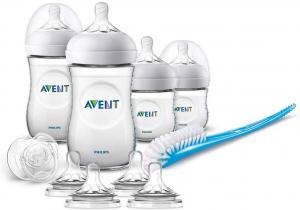
This set of Philips Avent bottles has nipples similar to the woman's breast and an advanced anti-colic system. The bottles are made of propylene, they are robust and hypoallergenic.
32,86 £ on AmazonThe Philips Avent SCD301/02 bottle feeding kit makes it easy to alternate between breastfeeding and bottle feeding. It has a wide nipple that is similar to the shape of the breast, and its cells soften and smooth the breast. In addition, it is based on a double valve system that reduces colic.
It should be noted that each bottle of this set is made of polypropylene, without BPA. And your baby can control the flow of milk as with breastfeeding. This Philips Avent SCD301/02 kit has the innovative system that avoids any discomfort for your baby. Moreover, it is compatible with the entire Philips Avent range. However, the only problem is that the bottles do not adapt to thickened milk.
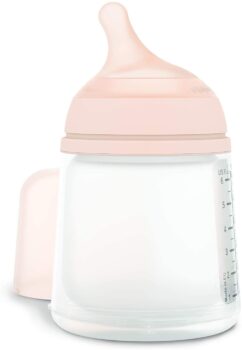
This bottle has been specially designed to facilitate the transition from breast to bottle. Also suitable for premature babies, it has a soft nipple imitating the mother's nipple as well as its properties to effectively limit colic.
10,32 £ on AmazonThis 160 ml anti-colic bottle is proof of the high quality of European manufacturing. And for good reason, it has won over many parents and has been easily adopted by many mixed feeding infants. Providing a sensation similar to that of the mother's breast, Suavinex Zero Zero has a nipple that retracts just like the mammary glands during sucking. This allows it to limit colic as much as possible. Indeed, the inclined shape of its teat prevents baby from ingesting air during feeding.
This bottle is highly recommended for premature babies and infants who have little sucking strength . Easy to hold, it is easy to maintain: just clean it with warm water after each use and it can be sterilized in a sterilizer (and especially not in the microwave) or in boiling water. Basically, it is a compact priced product without compromising on quality!
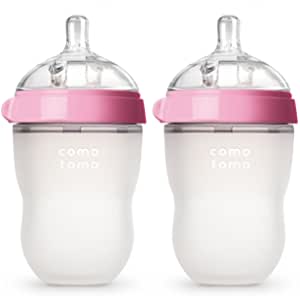
It is a set of two soft, hygienic silicone bottles that is a hit in the United States. It has helped many parents solve the problems of confusion or rejection of the bottle in their babies used to breastfeeding.
32 £ on Amazon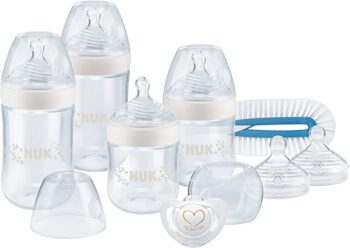
The 4 Nuk bottles in this set are suitable from birth to 18 months. As is often the case, some of the nipples in the kit are not suitable for thickened milk.
19,19 £ on AmazonThe Nuk Nature Sense baby set is ideal for the first months of our dear toddlers. Suitable from birth to 18 months, it includes 2 bottles of 150 mL with pacifier, 2 others of 260 mL with pacifier, a teething ring, a standard teat and an anti-colic teat. The material used is completely neutral and guaranteed free of BPA and allergens.
For information, the pacifiers adopt a shape very close to the maternal breast. We particularly appreciate their texture and their flexibility. Micro-holes are placed on them, which prevents baby from swallowing air. Moreover, the 4 bottles are protected by anti-leak caps. An excellent birth gift to offer and to offer yourself.
Any specific needs?
The best entry-level baby bottle
Your guide :
Rate this buying guide :By rating this buying guide, you are helping us to reward our best writers. Thank you!
| TOP OF THE TOP | CHEAP | EXCELLENT | VERY GOOD | |

In accordance with our commitment, this buying guide does not contain any sponsored products. |
 10/10 |
 8/10 |
 9/10 |
 8/10 |
| OUR SELECTION |
Philips Avent SCD301/02 Kit
|
Suavinex zero-colic bottle 180 ml
|
Biberons Comotomo natural feel (2 x 240 ml)
|
Nuk Nature Sense baby bottles (0-18 months)
|
|
This set of Philips Avent bottles has nipples similar to the woman's breast and an advanced anti-colic system. The bottles are made of propylene, they are robust and hypoallergenic.
|
This bottle has been specially designed to facilitate the transition from breast to bottle. Also suitable for premature babies, it has a soft nipple imitating the mother's nipple as well as its properties to effectively limit colic.
|
It is a set of two soft, hygienic silicone bottles that is a hit in the United States. It has helped many parents solve the problems of confusion or rejection of the bottle in their babies used to breastfeeding.
|
The 4 Nuk bottles in this set are suitable from birth to 18 months. As is often the case, some of the nipples in the kit are not suitable for thickened milk.
|
|
|
|
Bottles free of chemical materials
|
Also suitable for premature babies
|
Promise a smooth and easy transition from breast to bottle
|
Ultra soft and flexible nipples imitating the nipples of the maternal breast, bottles adopted by 92% of the babies
|
|
Box contents
|
2 260 ml bottles, 2 125 ml bottles, pacifier and brush
|
Imitates the texture and properties of the breast
|
Leak-free, anti-colic, mimicking the breast's nipple
|
Regular and natural milk flow thanks to the micro-piercings reproducing the micro-lactiferous channels of the breast
|
|
Age
|
1 month +
|
Anti-colic
|
Dishwasher, microwave and sterilizer safe
|
Bottles with anti-colic valve allowing an uninterrupted suckling as with a breast
|
Help us improve this table:
Report an error, request the addition of a feature to the table, or suggest another product. Thank you for your kindness!
We spend thousands of hours each year studying the major specialized websites, analyzing products of hundreds of brands and reading user feedback to advise you on the best products.
We are a product review company with a single mission: to simplify your buying decisions. Our research and testing helps millions of people every year find the best products for their personal needs and budget.
To support us you can: use our links to make your purchases (which often earns us a small commission), share our articles on social networks, or recommend our site on your blog. Thanks in advance for your support!
The material is the first criterion to consider when buying a baby bottle. Although they have aged, glass models offer many advantages. They are made of a 100% natural, sand-based material that is free of toxic substances that can have a negative impact on your baby's health. They are also extremely hard wearing and easy to maintain. However, a single drop could break the glass bottle and put your baby at risk of injury.
When it comes to plastic baby bottles, it's important to note that recent bottles do not contain Bisphenol A. This product is particularly toxic and can cause injury. This product is particularly toxic and can cause serious illness if ingested. Apart from the absence of toxic elements, this type of bottle has other advantages, among which we can mention its unbreakable side and its reduced weight. However, you should know that it quickly becomes tarnished when washed. After a few weeks of use, you will generally be forced to prepare your baby's meals in a bottle that is rather off-putting in terms of aesthetics.
After choosing the material (glass or plastic), you must consider the capacity. The choice of the latter must be made by taking into account the age of your child and the use of the bottle. In case the bottle will be used mainly for taking medicine, opt for a 30 to 50 mL model.
On the other hand, if the bottle will be used for juices and hydration, choose a small model of 90 to 150 mL. For formula feeding a baby from 0 to 9 months, a 240 mL bottle should be more than enough. Beyond 9 months, it's best to go with a larger 330-350 mL bottle.
When choosing a nipple, you should focus on flow rate, shape and material. The flow rate can vary greatly from one product to another. For a baby under 6 months, we recommend a low-flow nipple. Once your baby is older, you can change the nipple. As for the shape, a breast-shaped nipple could be useful when weaning. It will help your little one to forget breastfeeding quickly.
Once you've chosen the ideal flow rate and the best shape, consider the material. Some nipples are made of rubber, others of silicone. Rubber nipples are ideal for children who have difficulty sucking. However, they have a taste that may surprise some babies, especially after sterilization. Silicone teats are firmer. However, they are highly resistant to washing and their transparent side makes it easy to check their cleanliness before administering infant milk.
If you prefer plastic bottles, make sure they are free of toxic products and opt for a relatively new item that meets European and international standards. Be sure to check with the manufacturer and read the product label carefully. BPA-free models include glass, stainless steel or stainless steel bottles.
Before you choose a particular bottle, make sure it is easy for your baby to hold. So pay special attention to the shape of the bottle (triangular, S-shaped, etc.). Also make sure that they are easy to clean and that there are not too many parts to disassemble. Therefore, choose cylindrical models with a wide neck. Bottles with handles are easy for baby to hold as he grows. Triangular-shaped bottles have the advantage of not rolling around on the floor when dropped. However, their nooks and crannies are quite difficult to access when cleaning.
Anti-colic teats
Anti-colic teats have the particularity of being able to reduce or even eliminate colic in babies. This is made possible by their specific characteristics. First of all, they are flexible, easy to take in the mouth and are comparable to the maternal breast. Secondly, their anti-colic valve system allows them to prevent air from getting into the bottle and being swallowed by the baby during feeding. Finally, the anti-colic teats facilitate the transition from breastfeeding to bottle feeding thanks to their flat shape. In addition, their softness and suppleness give babies a sensation similar to that of a mother's nipple.
Anti-hiccup nipples
Anti-hiccup teats have an anti-hiccup valve. This valve ensures a constant and regular flow of air to prevent regurgitation, colic and hiccups.
Speed teats
Rubber and silicone nipples can have a speed. In general, there are 3 types of speed allowing the teat to adapt to baby's sucking rhythm: slow, medium and fast. It should be noted that the fast speed is only recommended for babies aged 6 months and over. However, this does not prevent the use of fast speed teats before the sixth month of your baby's life if he has a very important sucking rhythm. In any case, don't skip any steps. Consider testing medium-speed nipples first before using fast-speed nipples.
Flow teats
As the name suggests, these types of nipples offer three types of flow rates: slow, medium and fast. The flow rate corresponds to the flow of milk from the bottle. Slow flow nipples are perfect for babies with small appetites. If your baby is a glutton, choose the medium flow.
Variable-flow nipples
Variable flow nipples are special nipples that allow babies to control the flow of milk.
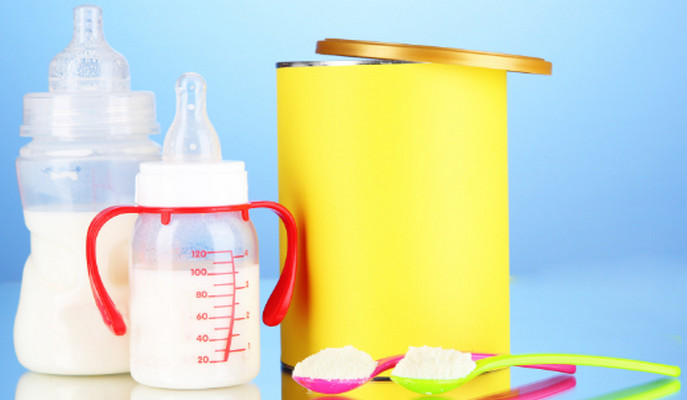
Standard bottles are the ones with the basic features that you are most likely to find in stores and drugstores. They are available in a variety of brands and are, for the most part, inexpensive. Standard bottles fit most standard nipples.
However, their narrow necks make them a little difficult to clean. Their main drawback? With these bottles, babies can swallow excess air during feedings.

Anti-colic bottles help reduce or even eradicate colic episodes in infants. This is because anti-colic bottles and nipples have been specially designed to prevent air from entering during sucking and usually operate a system based on venting valves. While most major brands claim that their bottles are able to relieve colic-prone babies, the effectiveness of this type of bottle varies from one baby to another.
Their different design also makes them a little more difficult to clean than other bottles on the market. They are also more expensive than regular bottles and are not as readily available as these.
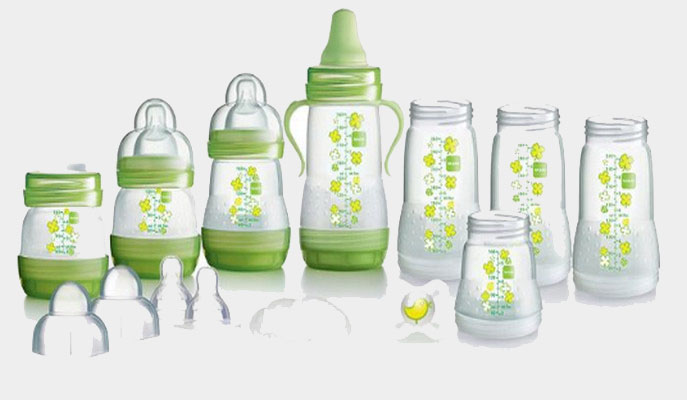
As the name suggests, these bottles can sterilize themselves. Water is poured into the bottom of the bottle and the remaining parts are placed on top and it is then heated in the microwave for the prescribed number of minutes. Self-sterilizing bottles do not require additional equipment for sterilization. They are convenient (especially when traveling and on the go) and time saving.
However, they are more expensive than regular bottles. Since every microwave is different, extra precautions must be taken to avoid overheating the self-sterilizing bottle.
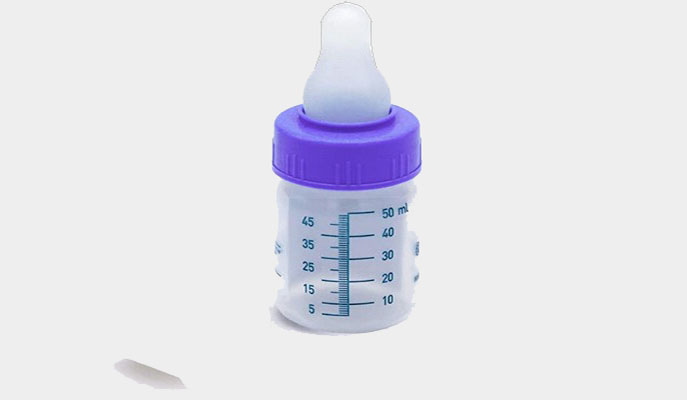
Disposable bottles are ready-to-use bottles, meaning that the bottle and its parts are already sterilized. Once used, the whole set can be thrown away. This avoids the hassle of cleaning. These disposable models are practical and time saving. They are also perfect for travel and can be used as a backup when you are in a hurry. They can be used by someone who is not familiar with bottle handling.
However, they are not environmentally friendly because they are disposable and some models are not made of biodegradable material. As for price, disposable bottles can be expensive if you use them on a regular basis.
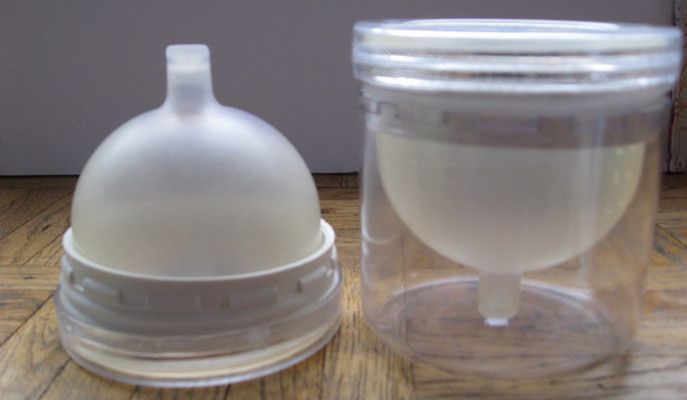
Most bottles that mimic a mother's nipple and its properties have specially designed nipples. These bottles are usually wide-necked and may have a more curved body. Their nipples are anatomically designed to resemble the shape and softness of a human breast to fit well in the baby's mouth, creating a natural feel. This is why the vast majority of babies adopt this type of bottle easily and the transition from breastfeeding to bottle feeding is made easier. These bottles are also easy to clean and sterilize, as the number of parts to be disassembled is minimal.
On the other hand, to enjoy the benefits of breastfeeding bottles, you have to pay a high price and depending on the brand and model of the bottle, finding replacement nipples can be difficult.
Artificial infant formulas are a nutritious alternative to breast milk and contain all the nutrients that breastfed babies need. Manufactured under sterile conditions, commercial formulas attempt to mimic breast milk by using a complex combination of proteins, sugars, fats and vitamins. While not as perfect as breast milk, they have been developed with input from many baby health experts to provide all the nutrients babies need for their age, condition and needs. Anti-reflux infant formulas, for example, are for babies who are prone to reflux, colic and regurgitation. There are also infant formulas specially formulated for premature babies. Women who choose formula over breastfeeding don't have to worry about their food affecting their baby. Bottles are very convenient and allow you to feed your baby anywhere, anytime. It also allows the father to feel more involved in the feeding process.
However, none of the antibodies found in breast milk are found in manufactured formulas. Formula cannot match the complexity of breast milk and is less digestible than breast milk. Because formula has not yet been able to match the complexity of breast milk, it must change as the baby's needs change. That's why there are infant formulas for 0 to 6 months, follow-on formulas for 6 to 12 months, and growing-up formulas for over 12 months. Besides all this, bottle-fed babies may have more gas and firmer stools than breastfed babies.
Breastfeeding provides ideal nutrition for babies and allows mom and baby to form a strong bond. An experience that many mothers cherish. A number of health organizations - including the American Academy of Pediatrics (AAP), the American Medical Association (AMA) and the World Health Organization (WHO) - recommend breastfeeding as the best choice for babies. Breastfeeding provides a baby's body with all the antibodies it needs to defend against infection, prevent allergies and protect against a number of chronic diseases.
However, there are some cases where breastfeeding is not recommended. This is the case if the mother has HIV or AIDS. The same is true for mothers who are undergoing chemotherapy or taking medications that may make breastfeeding unsafe. There is also the case where the mother is unable to breastfeed her child because her maternity leave is coming to an end and she must return to work. In such a situation, breast pumping is the right choice for working moms who want to offer their baby all the benefits of breast milk. For other moms, the discomfort generated by breastfeeding (pain, cracks, etc.) pushes them to turn to the bottle.
In conclusion, the choice between breastfeeding, mixed feeding or exclusive bottle feeding will depend mostly on you and your health. However, ideally, you should breastfeed your baby for the first six months. If you cannot do this because of your work or for any other reason, it is better to use infant milk in addition to breast milk that you can store with the help of a breast pump. If you really can't breastfeed your baby, make sure he or she is fed with infant milk adapted to his or her age and needs. It's true that breastfeeding for the first time can be uncomfortable, but know that it's only a little uncomfortable. Whenever possible, give your baby what's best for him.
For artificial or mixed breastfeeding
For many reasons, a mother cannot effectively meet her child's breast milk needs. Formula is an excellent alternative and although it can be given from a teaspoon, it is often more convenient and hygienic to use a bottle.
If you are unable to breastfeed your baby on a regular basis, a bottle is the essential equipment that will allow you to effectively meet your baby's feeding needs. This type of equipment can be used for artificial feeding and for mixed feeding (combining breastfeeding and artificial feeding).
For taking medication
Up to a certain age, your baby can contract various diseases. Unlike children over 2 years old and teenagers, it is not always easy to administer medication to an infant. In this more or less complex exercise, the bottle can be of great help. On the one hand, it facilitates the ingestion of medication and on the other hand, it significantly reduces the risks of loss.
For weaning
In most cases, it is not advisable to stop giving breast milk overnight. Weaning should be done gradually to avoid breast engorgement, reduce the risk of mastitis and to avoid rushing the baby.
As a general rule, it should last 4 weeks during which you should alternate breastfeeding and formula feeding. In other words, you'll need to invest in a bottle in order to effectively administer formula during this period.
Note that small nutritious snacks can significantly reduce milk intake. However, it's important to know that your baby won't be able to go without his favorite drink for a while.
In our opinion, the best brands of baby bottles in 2022 are :
Philips leverages cutting-edge technology and in-depth clinical and consumer insights to deliver integrated solutions. The company is a leader in diagnostic imaging, image-guided therapy, patient monitoring and health informatics, as well as consumer health and home care.
Suavinex was founded in 1983. In a particular space and time, enough material and energy came together to create a project that would eventually revolutionize the baby care industry. Today, it has become the first company to transform pacifiers, bottles and pacifier clips into real fashion accessories for babies.
The Comotomo brand is dedicated and devoted entirely to the design of baby products. Their motto is to become a producer that offers better than good articles to satisfy its consumers, but also to offer more safety to babies. This brand is serious, reliable and of high quality.
The NUK Nature Sense allows babies to enjoy a familiar feeling when they drink. A feeling that is even closer to breastfeeding. This brand focuses on the quality it offers for the sake of babies and their comfort. The quality of NUK products is impeccable.
MAM is a brand specialized in childcare. It offers a wide range of choices for its products, especially for baby bottles. The brand gives priority to the comfort of the infant, but also to the quality of the product and the aesthetics which contribute effectively to the appetite of the baby.
The diagram below will help you to get an idea of the typical prices for each price range (entry-level, mid-range and high-end).
However, more expensive does not necessarily mean better.
We therefore advise you to always consult our ranking before deciding, rather than blindly relying on price ranges.
Check the temperature carefully.
It is better for the milk to be a little too cold than too hot. Use the inside of your wrist to check the temperature, if you don't glow, the milk is the right temperature for the baby.
Just relax.
This
may be the quietest time of your day with a newborn, so take advantage of it. Make yourself comfortable, because the more relaxed you are, the more comfortable the baby will be. Conversely, if you're too tense, the baby may hate the experience and be apprehensive about feeding in the future.
Make sure your baby is drinking milk and not sucking in air.
Make sure
the bottle is in the right position: angled, but not at the same height as the baby's mouth. If the bottle is tilted, the nipple will still be full of milk, and when the baby sucks in it's milk, not air.
Start early.
If
your baby is going to be bottle-fed when you go back to work, it's best to get her used to it as soon
as possible.
Give yourself and your baby enough time to change your routine. If you plan to switch to formula, try to get Baby comfortable with bottle feeding with breast milk before switching to formula.
Take burp breaks.
All
babies need to burp after they eat. Because bottle-fed babies can suck in more air, which can make them uncomfortable, it's a good idea to take a break every now and then to burp.
Silicone nipples are easily recognizable: they are clear and shiny. They have a longer life span, but are more rigid. Rubber nipples, on the other hand, are matte, amber, and rather opaque. They are much softer and more flexible, but will wear out more quickly (less than 6 months.) The choice is yours.
It is best not to put your baby's bottle directly into the microwave to heat the milk. The container and its contents may be heated unevenly. This could burn your child's mouth when feeding.
It depends on your little one's appetite. Just know that since infant milk is less digestible than breast milk, allow two to four hours between feedings to give your little one's stomach time to digest properly.
Once you see that your child always finishes (or almost finishes) his bottles, increase his intake.
Remember to change the nipple immediately once it gets old, scratched, cracked or worn out. Changing nipples also depends on your child's needs and age. The older your child gets, the more he or she will need nipples with a greater flow rate. In any case, it is recommended to change the nipples every 6 to 8 weeks. Some bottles have a replacement date on the packaging.
Every month we help more than 1 000 000 people buy better and smarter.
Copyright © 2022 - Made with ♥ by buyingbetter.co.uk
Your reviews and buying guides 0% advertising, 100% independent!